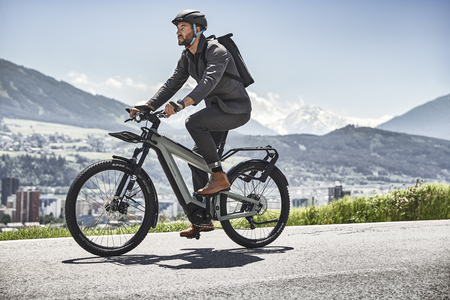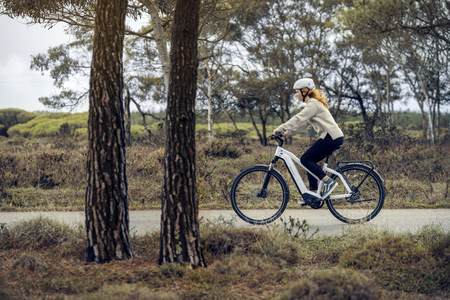What are the potential savings on transport?
Cycling is about as cheap as transport modes come apart from walking and you’ll also gain the warm feeling of knowing you’re getting in a healthy dose of exercise, but with the added bonus of arriving fresh.
On a purely cost comparison basis, it makes good sense to cut out your fuel or train ticket spend and invest in the electric bike. Powering up a typical e-Bike costs between two and four times that of boiling a kettle (2.5p), depending on both your electricity supply and battery spec.
A quick calculation based on a fairly typical entry-level electric commuter bike - let’s say Ridgeback’s £1,899 Electron. This bike claims a 40 kilometre range on typical riding conditions, so if your daily round trip were 10 kilometres and you commuted by bike four out of five working days, then you’d only need to charge once per week, perhaps with a small top up if you happen to be in a particularly hilly area.
At 52 charges for the year, your annual electricity bill would be affected to the tune of between £5.20 and £10.40. You could always just plug in at work, of course.

What type of e-bike is right for me?
That, of course, depends on your needs and physical limits, but what we will say is that it’s okay to dare to dream with an electric bike. That mountain that you’ve always dreamed of cycling up is now in reach for the vast majority of people - age, fitness, motivation – all of these factors are overcome with an electric bike.
Thanks to sensors in the motor and a range of settings, often spanning eco through to ‘boost’, the only limiting factor standing between you and glory is a full charge of the battery, which will tend to drain slightly faster as the topography steepens. Technology has come a long, long way in even just the past five years, however. Lithium Ion batteries are a vast improvement on the lead acid batteries of old in that they’re now engineered to be lighter, last longer and charge faster, leaving you only to worry about remembering to plug in once in a while.
As for which e-Bike is right for you, the question needn’t have the ‘e’ infront. If you intend to go off road, then seek out a gravel bike for lighter fire road use, or a full suspension e-MTB if you intend to ride more rugged terrain.
In the city, if you want to haul a single bag of shopping or commute, then the electric folding and compact bike segments will likely satisfy, but if your intention is to move home by bike (yes, people do it), then the e-Cargo bike is a fine solution.
We strongly recommend visiting a friendly local bike shop for advice on what gear best suits your needs, or try a new service like Ribble’s online live chat to speak to an expert in the comfort of your own home.

What are the main benefits of light assistance?
From our perspective at Cycling Electric, having seen first-hand the “e-Bike smile” on a range of faces, the number one benefit has to be the social element. With light assistance it really is possible to take grandparents, less-than enthusiastic about cycling teenagers, those with low levels of fitness or underlying health concerns, or even simply to keep the pace with a fitter cycling club peloton. It is, in short, inclusivity.
When it comes to health benefits, don’t be fooled by the notion that you’re somehow cheating. Studies have found that electric bike users use almost as much cardiovascular function as pedal cyclists; you are very much still exercising, but with the feeling of a tailwind when the going would otherwise get tough. For this reason, the electric bike is an excellent gateway back into exercise, but with low risk on straining the body beyond its’ limits.
From both a utility and business perspective, the electric bike is already transforming our streets. Logistics businesses large and small are already turning to the electric bike, in particular the electric cargo bike. Via these vehicles we can achieve faster, cheaper and more efficient deliveries than vans can in urban spaces.
For the unconfident cyclist or those wishing they could but have reservations, the added benefit of pedal-assistance gives you a jump start off the traffic lights, putting you ahead of traffic and upright with a good view of the road or path ahead. It is a confidence inspiring feeling where before you might have felt a wobble when setting off.
Those seeking adventure will be thrilled to have the sting taken out of otherwise back breaking climbs. If you’ve dreamed of summiting a mountain for sunrise, the electric bike will take the sting out of the first mile and then propel you further when your legs begin to fatigue. Ultimately this means you can ride for longer and further than you typically might.

How fast do e-bikes go?
The answer to this question will be fairly boring to anyone that had expected to be leaping aboard a motorbike, electric bikes in the UK are legally only permitted to deliver pedal-assistance up to 15.5mph. From there on in, you’re on your own if you wish to go faster.
An electric bike supplied here will have a motor with a power output not beyond 250 watts. All of this means that in terms of power output motors will all do roughly the same thing, though some differences to look out for if you are seeking performance is low noise, low friction and no drastic and sudden drop in performance due to overheating. Most modern motors have engineered all of these issues out, but the saying “buy cheap, buy twice” may apply if you are picking a lesser known or unmarked motor maker’s product. This rule applies to all electric bikes sold in the UK, excluding Northern Ireland where the law differs and an electric bike is currently governed under the same laws as a moped – that’s mandatory licence, insurance, tax and certified helmet. That said, at the time of writing the word on the grapevine is that legislation may soon align.


